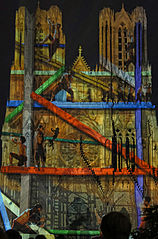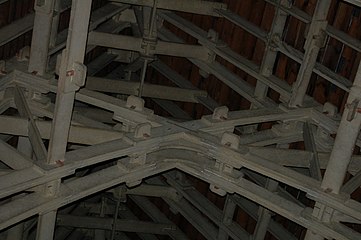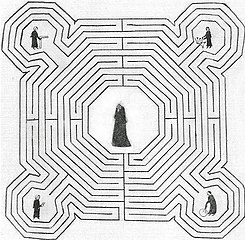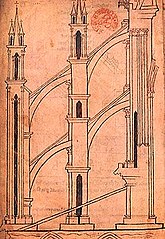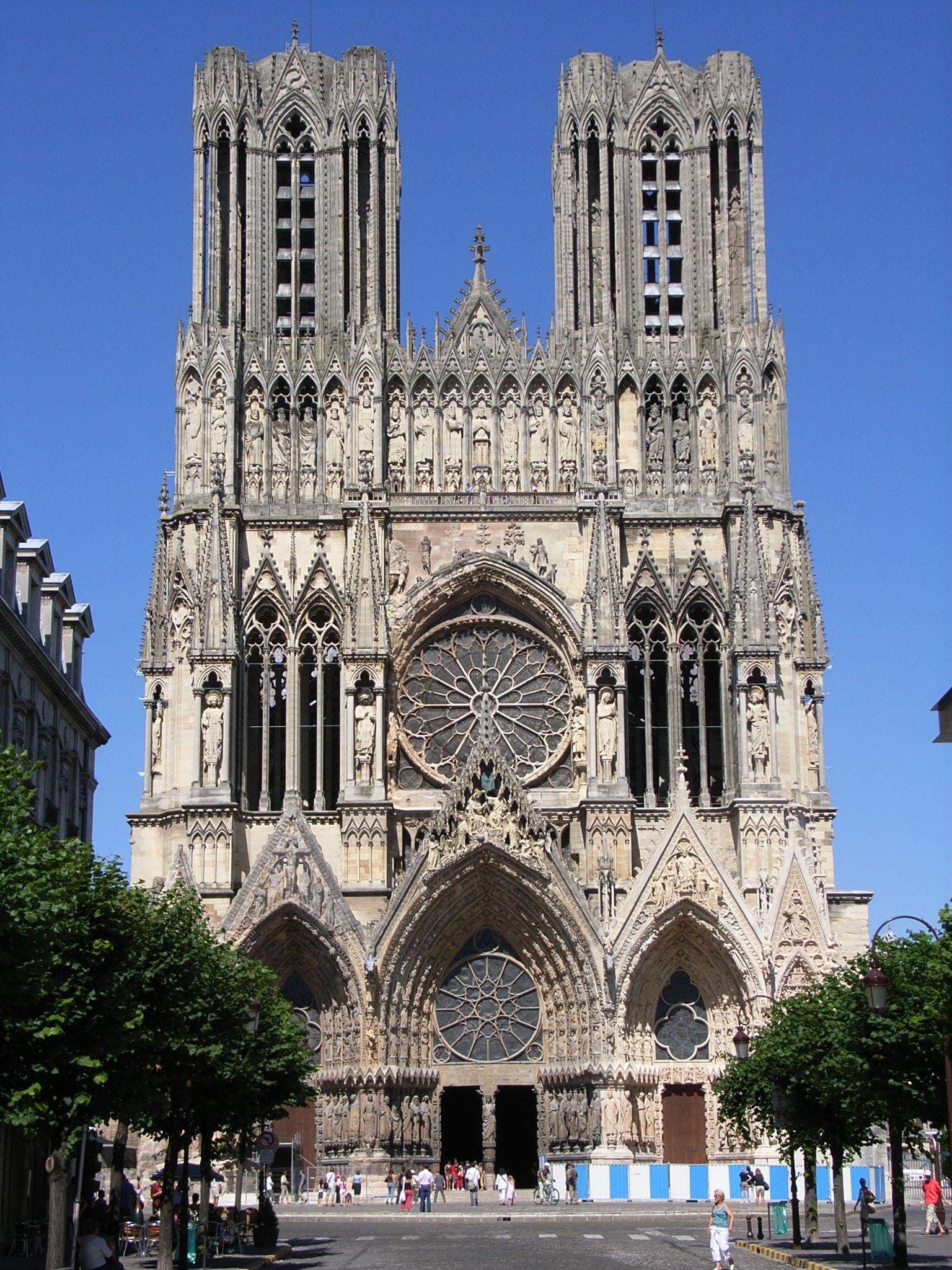
Reims Cathedral
Notre-Dame de Reims (/ˌnɒtrə ˈdɑːm, ˌnoʊtrə ˈdeɪm, ˌnoʊtrə ˈdɑːm/;[2][3][4] French: [nɔtʁə dam də ʁɛ̃s] ; meaning "Our Lady of Reims"),[a] known in English as Reims Cathedral, is a Roman Catholic cathedral in the French city of the same name, the archiepiscopal see of the Archdiocese of Reims. The cathedral was dedicated to the Virgin Mary and was the traditional location for the coronation of the kings of France. Reims Cathedral is considered to be one of the most important pieces of Gothic architecture.[5] The cathedral, a major tourist destination, receives about one million visitors annually.[6] It became a UNESCO World Heritage Site in 1991.[7]
Reims Cathedral
Place du Cardinal Luçon, 51100
Reims
France
Active
Jean d'Orbais
Jean-le-Loup
Gaucher of Reims
Bernard de Soissons
1211–1345
1211
1275
149.17 m (489.4 ft)
6,650 m2 (71,600 sq ft)
2
81 m (266 ft)
2 (in south tower)
Reims (Seat)
Jean-Pierre Laurent
Cathedral of Notre-Dame, Former Abbey of Saint-Rémi and Palace of Tau, Reims
Cultural: i, ii, vi
1991 (15th Session)
Cathédrale Notre-Dame
1862, 1920[1]
The cathedral church is thought to have been founded by the bishop Nicasius in the early 5th century. Clovis was baptized a Christian here by Saint Remigius, the bishop of Reims, about a century later. He was the first Frankish king to receive this sacrament. Construction of the present Reims Cathedral began in the 13th century and concluded in the 14th century. A prominent example of High Gothic architecture, it was built to replace an earlier church destroyed by fire in 1210. Although little damaged during the French Revolution, the present cathedral saw extensive restoration in the 19th century. It was severely damaged during World War I and the church was again restored in the 20th century.
Since the 1905 law on the separation of church and state, the cathedral has been owned by the French state, while the Catholic church has an agreement for its exclusive use. The French state pays for its restoration and upkeep.[7]
History[edit]
5th century – the Merovingian Cathedral[edit]
The settlement of a tribe of Gauls called the Remes, named Durocortorum, had been recorded by Julius Caesar in his accounts of the Gallic Wars.[8] During the High Roman Empire, it became the capital of a province extending to the delta of the Rhine, and in the 3rd century A.D. was capital of the Roman province known as Second Belgium. The first Christian church there was founded by the first bishop, Saint Sixtus of Reims between 250 and 300.
At the beginning of the 5th century, in the Merovingian period, the Bishop Nicasius transferred the cathedral its present location, the site formerly occupied by Gallo-Roman bath built by the Emperor Constantine.[9][10] The new church was dedicated to the Virgin Mary, anticipating the decision of the Council of Ephesus in 431 establishing her enhanced status.[11] The new cathedral, with the plan of a square exterior and a circular interior,[12][13] measured approximately 20 m (66 ft) by 55 m (180 ft).[14][8] In the 1990s, the Baptistry of this original Merovingian church, directly under the present cathedral, was excavated and fragments of the old structure were brought to light.[8]
Clovis I, the King of the Franks, was baptised there in about 496 A.D. by Saint Remigius (also known as Saint Remi). This was the event that inspired the long tradition of royal coronations at Reims.[15][16][17]
9th century – the Carolingian cathedral[edit]
In 816, Louis the Pious, the King of the Franks and Emperor of the Holy Roman Empire, was crowned in Reims by Pope Stephen IV.[12] The coronation and ensuing celebrations revealed the poor condition and inadequate size of the early cathedral.[16] Beginning in about 818, the archbishop Ebbo and the royal architect Rumaud began to build a much larger church from the ground up on the same site, using stone from the old city ramparts.[12][18]
The work was interrupted in 835, and then resumed under a new archbishop, Hincmar, with the support of Emperor Charles the Bald. The interior of the church was adorned with gilding, mosaics, paintings, sculptures and tapestries.[13] On 18 October 862, in the presence of the Emperor, Hincmar dedicated the new church, which measured 86 m (282 ft) and had two transepts.[19]
At the beginning of the 10th century, an ancient crypt underneath the original church was rediscovered. Under the archbishop Heriveus, the crypt (which had been the initial centre of the previous churches above it) was cleared, renovated, and then rededicated to the sainted bishop Remigius.[12] The cathedral altar is still in the same place, directly over the crypt, where it has been for 15 centuries.[19]
Beginning in 976, the archbishop Adalbero began to enlarge the Carolingian cathedral.[20] The historian Richerus, a pupil of Adalbero, gives a very precise description of the work carried out by the archbishop:[21]
Exterior[edit]
West façade[edit]
The west façade, the entry to the cathedral, particularly glorifies royalty. Most of it was completed at the same time, giving it an unusual unity of style. It is harmonic or balanced, with two towers of equal height and three portals entering into the nave. The porches of the portals, with archivolts containing many sculptures, protrude from the main wall.[46]
Above and slightly behind the central portal is a large rose window at the level of the clerestory, with tall arched windows flanked by statuary under pointed canopies projected forward. Above this level is the gallery of kings, composed of 56 statues with a height of 4.5 m (15 ft), with Clovis I, the first Christian king of the Franks, in the center, Clotilde to his right, and Saint Remigius to his left. The two bell towers were originally planned to have spires making them three times taller than the nave, but these were never rebuilt.
Interior[edit]
Interior of the west wall[edit]
One distinctive feature of Reims Cathedral not found in other High Gothic cathedrals is the wall of sculpture on the inside of the west façade. Some of the statues, particularly around the doors, were badly damaged by fire after the bombardment of the church in 1914, but the wall has been substantially restored. Some of the sculpture continues the biblical stories illustrated on the west façade, such as the Apocalypse, while other themes are found only in the interior. Some scenes link Biblical events to more recent historical events; the wall illustrates the baptism of Christ by John the Baptist, parallel with the baptism of Clovis by Saint Remigius. Particularly attention is given to local saints such as Nicasius.[73] One celebrated scene is the communion of the knight; the Old Testament patriarch Abraham, in the medieval armor of a knight, is being offered bread and wine by the priest-king Melchizedek, a preview of the Eucharist in the New Testament.[73]
Stained glass[edit]
Interior of west façade[edit]
In the interior of the west façade, much of the original glass remains, though it has gone through several restorations. The centre of the west rose window depicts the Dormition of the Virgin. It complements the scene of the crowning of the Virgin Mary in sculpture on the exterior of the façade The circles of glass medallions in the window, from the centre outwards, represent the twelve apostles, angel musicians, and the kings and prophets of the Old Testament. The windows in the bays of the triforium, just below the rose window, depict the coronations of the kings of France, and are the stained glass equivalent of the gallery of kings on the façade.[81]
The windows in the west portals are more modern; the small rose over the central portal was made by Jacques Simon in 1938, and is devoted to scenes related to the Virgin Mary, while the glass in the lateral tympanums is from 1959, with scenes from the life of Christ.
The episcopal palace, known as the Palace of Tau, adjoins the cathedral on the south side of the apse. It was the residence of the archbishop, and also was the setting for the banquet given in honour of the new kings of France after their coronation.[81]
The episcopal palace has its own chapel, in the High Gothic style, directly alongside the cathedral. It has no collateral aisles and three levels, with tall lancet windows, and is more sober in its decoration than the neighbouring cathedral. It previously had its own flèche or spire, a symbol of the status of an archbishop. The adjoining residential wing was originally constructed in the Flamboyant Gothic style, but was largely reconstructed between 1686 and 1693 by the architect Robert de Cotte in a more classical style, including a triangular fronton over its façade a monumental double stairway. The upper floor of this wing contains the hall used for the coronation banquets.[81]
The cathedral art collection includes a very fine collection of tapestries, which formerly hung in the choir of the cathedral, and now are displayed in the cathedral aisles in summer season and in the Palace of Tau during the rest of the year.
Two tapestries, made in Flanders, depict scenes from life of the Clovis. They were presented, as part of a larger set to the cathedral in 1573 by Cardinal Charles of Lorraine. Another set of tapestries was presented to the cathedral in 1530 by Robert de Lenoncourt, archbishop under Francis I (1515–1547). They are of either local or possibly Flemish manufacture, and represent the life of the Virgin, and the how her role may have been prefigured in the Old Testament.[84]
The cathedral treasury contains an important collection of precious objects, particularly reliquaries, some of which were used in coronations or donated by French monarchs at the time of their coronation. These include the Holy Ampulla (French: Sainte Ampoule, lit. 'holy ampulla'), the successor of the ancient one that contained the oil with which French kings were anointed. It was broken during the French Revolution, but a fragment is contained in the present flask. The Talisman of Charlemagne (12th century), contains a purported fragment of the True Cross, and is decorated with sapphires, gold, emeralds and pearls. The "Chalice of Saint Remigius" is said to be the cup used in the coronation of Clovis, and was used in later coronations. It is a 12th-century cup adorned in the 19th century with pearls and precious stones.[85]
800th anniversary[edit]
In 2011, the city of Reims celebrated the cathedral's 800th anniversary. The celebrations ran from 6 May to 23 October. Concerts, street performances, exhibitions, conferences, and a series of evening light shows highlighted the cathedral and its 800th anniversary. In addition, six new stained glass windows designed by Imi Knoebel, a German artist, were inaugurated on June 25, 2011. The six windows cover an area of 128 m2 (1,380 sq ft) and are positioned on both sides of the Chagall windows in the apse of the cathedral.












